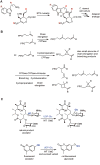Opportunities for enzyme engineering in natural product biosynthesis
- PMID: 19201253
- PMCID: PMC2695590
- DOI: 10.1016/j.cbpa.2009.01.005
Opportunities for enzyme engineering in natural product biosynthesis
Abstract
Organisms from all kingdoms of life produce a plethora of natural products that display a range of biological activities. One key limitation of developing these natural products into pharmaceuticals is the inability to perform effective, fast, and inexpensive structure-activity relationship studies (SAR). Recently, enzyme engineering strategies have allowed the exploration of metabolic engineering of biosynthetic pathways to create new 'natural' products that can be used for SAR. The enzymes that enable the biosynthesis of natural products represent a largely untapped resource of potential biocatalysts. A challenge for the field is how to harness the wealth of reaction types used for natural product metabolism to obtain useful biocatalysts for industrial biotransformations.
Figures



Comment in
-
Engineering enzymes by 'intelligent' design.Curr Opin Chem Biol. 2009 Feb;13(1):1-2. doi: 10.1016/j.cbpa.2009.02.022. Epub 2009 Mar 9. Curr Opin Chem Biol. 2009. PMID: 19272831 Free PMC article. No abstract available.
References
-
- Dewick P. Medicinal Natural Products: A Biosynthetic Approach. 2. Wiley; 2002.
-
- Koehn FE, Carter GT. The evolving role of natural products in drug discovery. Nat Rev Drug Discov. 2005;4:206–220. - PubMed
-
- Wilkinson B, Micklefield J. Mining and engineering natural-product biosynthetic pathways. Nat Chem Biol. 2007;3:379–386. - PubMed
-
- Baker DD, Chu M, Oza U, Rajgarhia V. The value of natural products to future pharmaceutical discovery. Nat Prod Rep. 2007;24:1225–1244. - PubMed
-
- Blanchard S, Thorson JS. Enzymatic tools for engineering natural product glycosylation. Curr Opin Chem Biol. 2006;10:263–271. - PubMed
Publication types
MeSH terms
Substances
Grants and funding
LinkOut - more resources
Full Text Sources
Miscellaneous

